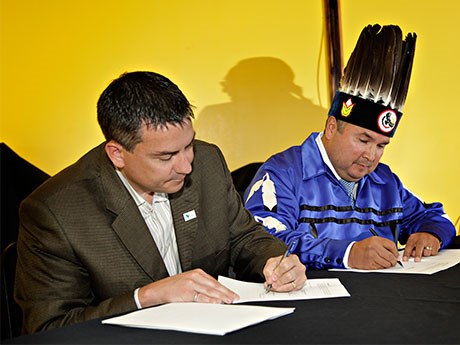Sagamok First Nation sees benefits from Totten
A decade ago, mineral extraction was just a blip on the radar of the Sagamok Anishnawbek First Nation. Now the community is collaborating with Vale on how it can benefit from the development of Totten Mine.
The community, located 70 kilometres west of the mine along the north shore of Lake Huron, has an on-reserve population of 1,600, and an additional 1,000 off-reserve band members scattered across Canada and the U.S. Vale’s new, $760-million mine backs onto Sagamok’s traditional territory. Collaboration between Vale and the community has been an evolving process, said Sagamok Chief Paul Eshkakogan.
“I look back at that time and where we’re at now and I’m amazed at the amount of capacity that I think we’ve built, and also with Vale because there wasn’t a template out there for us to follow,” he said. “Things have changed quite a bit in the resource development area as it relates to working with First Nation communities.”
Sagamok elders and community members, who realized resource development was going to become a reality for the community, showed great foresight in developing the community’s mineral strategy in 2003, the chief said.
Not all community members agreed with resource development on traditional lands, but all saw the importance of being at the table for discussions rather than be left behind, Eshkakogan said.
When deliberations began in earnest with Vale around 2006, the community was prepared. In negotiating an impact and benefit agreement (IBA) with Vale, Eshkakogan said consideration for the impact on the environment was a key priority. In particular, the community paid close attention to the mine closure plan, commissioning a third-party assessment to ensure the community understood and agreed with the plan’s technical components.
“We asked to be involved in the environmental monitoring, and that’s part of the IBA, but we didn’t want to be involved in a way where we were just going around collecting water samples,” Eshkakogan said. “We want to be involved in the actual management, the decisions that are made.”
Discussions are still underway about how Sagamok can be involved in environmental monitoring, but the chief said due diligence is important to the community.
“We certainly want to be afforded every opportunity, but at the same time we want to ensure that we’re ready to meet those opportunities and those challenges that come with it,” Eshkakogan said.
The community is already benefiting from other relationships with industry partners, including Cementation, Glencore Xstrata and KGHM through its New Miner Training Program, which sets up community members with common core training for working underground.
Participants get in-house training in the community, after which they’re sent to Cementation’s training facility in Lively. From there, they are sent for on-the-job training with one of the partners. Eshkakogan sees it as an acrossthe-board win for both Sagamok and industry.
“Everybody’s talking about this labour shortage that’s going to happen, so we said, ‘Hey, we’ve got 200 or 300 young people who are on social assistance at any given time here, a good young vibrant labour force that just needs an opportunity,’” Eshkakogan said.
Sagamok has also secured the contract to haul ore from Totten to Clarabelle Mill in Sudbury. Working with T. Bell Transport in Nairn Centre, just outside of Sudbury, Sagamok will train drivers, mechanics and office staff, building capacity along the way.
T. Bell has been supportive of the endeavour, offering scholarships, participating in graduation ceremonies and providing financial support for education, and language and cultural retention.
“The life of the mine is approximately 25 years with the potential of maybe even being longer if they find additional resources there,” Eshkakogan said. “So that’s something that we’re really looking forward to.”
The biggest challenge facing the community to date has been working within the timelines set by the Ministry of the Environment. Only 45 days for a First Nation to respond following a miner’s filing of its closure plan is not enough time, Eshkakogan said.
It puts pressure on both parties to make a decision quickly, and more time should be afforded the parties to come to an agreement.
“(Mining companies) have to be accountable to their shareholders, but at the same time, First Nation communities have to be accountable to their people and what they want, and they have to try to get those things for them,” he said.



